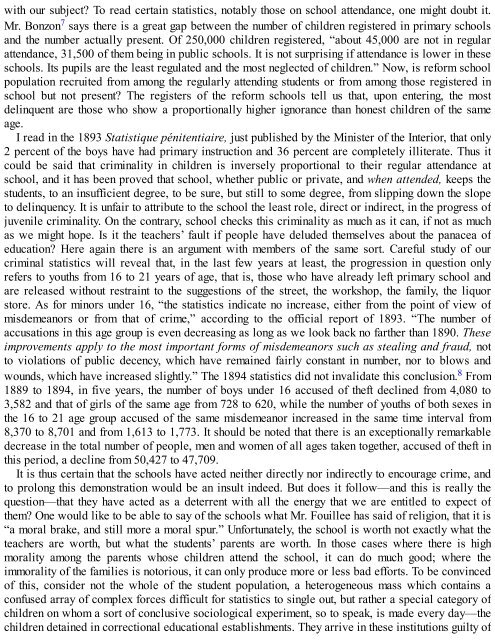3658925934
You also want an ePaper? Increase the reach of your titles
YUMPU automatically turns print PDFs into web optimized ePapers that Google loves.
with our subject? To read certain statistics, notably those on school attendance, one might doubt it.<br />
Mr. Bonzon 7 says there is a great gap between the number of children registered in primary schools<br />
and the number actually present. Of 250,000 children registered, “about 45,000 are not in regular<br />
attendance, 31,500 of them being in public schools. It is not surprising if attendance is lower in these<br />
schools. Its pupils are the least regulated and the most neglected of children.” Now, is reform school<br />
population recruited from among the regularly attending students or from among those registered in<br />
school but not present? The registers of the reform schools tell us that, upon entering, the most<br />
delinquent are those who show a proportionally higher ignorance than honest children of the same<br />
age.<br />
I read in the 1893 Statistique pénitentiaire, just published by the Minister of the Interior, that only<br />
2 percent of the boys have had primary instruction and 36 percent are completely illiterate. Thus it<br />
could be said that criminality in children is inversely proportional to their regular attendance at<br />
school, and it has been proved that school, whether public or private, and when attended, keeps the<br />
students, to an insufficient degree, to be sure, but still to some degree, from slipping down the slope<br />
to delinquency. It is unfair to attribute to the school the least role, direct or indirect, in the progress of<br />
juvenile criminality. On the contrary, school checks this criminality as much as it can, if not as much<br />
as we might hope. Is it the teachers’ fault if people have deluded themselves about the panacea of<br />
education? Here again there is an argument with members of the same sort. Careful study of our<br />
criminal statistics will reveal that, in the last few years at least, the progression in question only<br />
refers to youths from 16 to 21 years of age, that is, those who have already left primary school and<br />
are released without restraint to the suggestions of the street, the workshop, the family, the liquor<br />
store. As for minors under 16, “the statistics indicate no increase, either from the point of view of<br />
misdemeanors or from that of crime,” according to the official report of 1893. “The number of<br />
accusations in this age group is even decreasing as long as we look back no farther than 1890. These<br />
improvements apply to the most important forms of misdemeanors such as stealing and fraud, not<br />
to violations of public decency, which have remained fairly constant in number, nor to blows and<br />
wounds, which have increased slightly.” The 1894 statistics did not invalidate this conclusion. 8 From<br />
1889 to 1894, in five years, the number of boys under 16 accused of theft declined from 4,080 to<br />
3,582 and that of girls of the same age from 728 to 620, while the number of youths of both sexes in<br />
the 16 to 21 age group accused of the same misdemeanor increased in the same time interval from<br />
8,370 to 8,701 and from 1,613 to 1,773. It should be noted that there is an exceptionally remarkable<br />
decrease in the total number of people, men and women of all ages taken together, accused of theft in<br />
this period, a decline from 50,427 to 47,709.<br />
It is thus certain that the schools have acted neither directly nor indirectly to encourage crime, and<br />
to prolong this demonstration would be an insult indeed. But does it follow—and this is really the<br />
question—that they have acted as a deterrent with all the energy that we are entitled to expect of<br />
them? One would like to be able to say of the schools what Mr. Fouillee has said of religion, that it is<br />
“a moral brake, and still more a moral spur.” Unfortunately, the school is worth not exactly what the<br />
teachers are worth, but what the students’ parents are worth. In those cases where there is high<br />
morality among the parents whose children attend the school, it can do much good; where the<br />
immorality of the families is notorious, it can only produce more or less bad efforts. To be convinced<br />
of this, consider not the whole of the student population, a heterogeneous mass which contains a<br />
confused array of complex forces difficult for statistics to single out, but rather a special category of<br />
children on whom a sort of conclusive sociological experiment, so to speak, is made every day—the<br />
children detained in correctional educational establishments. They arrive in these institutions guilty of









![Genki - An Integrated Course in Elementary Japanese II [Second Edition] (2011), WITH PDF BOOKMARKS!](https://img.yumpu.com/58322134/1/180x260/genki-an-integrated-course-in-elementary-japanese-ii-second-edition-2011-with-pdf-bookmarks.jpg?quality=85)
![Genki - An Integrated Course in Elementary Japanese I [Second Edition] (2011), WITH PDF BOOKMARKS!](https://img.yumpu.com/58322120/1/182x260/genki-an-integrated-course-in-elementary-japanese-i-second-edition-2011-with-pdf-bookmarks.jpg?quality=85)





